It’s been a while since we hit feature complete. That shifted game development into a different phase: making everything work. This is both a matter of finding and fixing bugs, and balancing and tuning the economic game and the overall story to make sure things are fun. There’s usually not a lot of interesting things to say, which is partly why there hasn’t been a development blog post in a while. We found bugs, we fixed bugs. Day after day.
We did notice that two of the story themes could intertwine a bit more, so Robin Laws wrote two scenes to deal with that, and another three that deal with individual leaders. Those are now coded.
We invited a small number of outside playtesters to give their feedback, and have been trying to improve and clarify things based on that.
It’s possible to win the game without encountering bugs: one playtester said, “I’m embarrassed to report I haven’t found an obvious bug yet. Did complete a play in easy.” But there still are a lot of issues we need to fix. They may show up only when you get two scenes in a particular order, or have a specific combination of advisors, or choose a play style. Any one player won’t see them, but they need to be fixed. It’s hard to know how many of these there are. And analyzing them can be tricky. Did someone run out of cows because the game is broken, or because they made poor decisions, or because the user interface let them trade away more than they intended?
Between QA and playtesters, we’re still finding enough issues that I don’t think the game is high enough quality to ship in the near future. And a few areas aren’t completely tested (such as making sure every achievement can actually be earned).
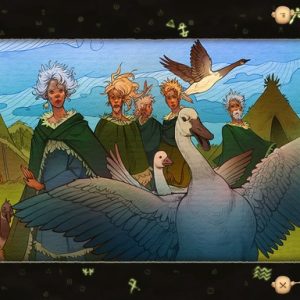 There’s another complication to figuring out a ship date: we’re moving. After five years in Philadelphia, A Sharp will be returning to the Pacific Northwest next month. (We’re heading to Tacoma, mostly for family reasons.) Coordinating this and physically moving across the United States is going to take a fair amount of time.
There’s another complication to figuring out a ship date: we’re moving. After five years in Philadelphia, A Sharp will be returning to the Pacific Northwest next month. (We’re heading to Tacoma, mostly for family reasons.) Coordinating this and physically moving across the United States is going to take a fair amount of time.
Without a reliable completion date, and with relocation thrown in, it doesn’t make sense to try to release the game this year. (“This year” would realistically mean “before the Christmas holidays,” so there are only 2 months left anyway.)
So we are moving our guess at a release date to 2018. We want to make sure the game is done right, and we want to have some lead time to start marketing.
I’m disappointed that we aren’t done yet, but I think the project is in good shape. As a complex bit of software that’s in alpha, the number of bugs feels reasonable. And one playtester wrote, “I have been spending waaaaay too much time playing this game. I am every bit as addicted to it as I was to KoDP the first time it was released, and I thought I was over that kind of behavior.”
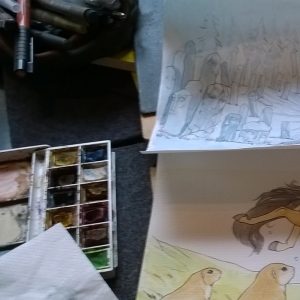
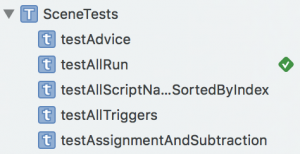 Given how many scenes are in the game, I figure any bug is probably somewhere else as well. So figured I should go back to our
Given how many scenes are in the game, I figure any bug is probably somewhere else as well. So figured I should go back to our 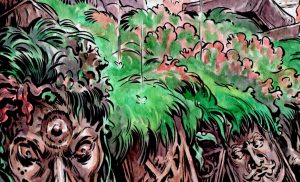 Six Age has a lot of art, and it’s almost all complete. I just sent out the final assignment today. We may still do a little reworking of illustrations and UI assets, but technically what’s there now could ship.
Six Age has a lot of art, and it’s almost all complete. I just sent out the final assignment today. We may still do a little reworking of illustrations and UI assets, but technically what’s there now could ship. We’ve been working with
We’ve been working with 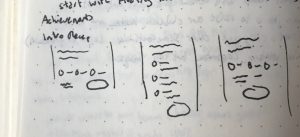 I want to show an explanation of the chosen difficulty, so I mocked up a couple UI designs. Now that it’s in the game, I may further tweak the intro (because it is indeed one more choice, and takes up space on a screen that may make other items less prominent).
I want to show an explanation of the chosen difficulty, so I mocked up a couple UI designs. Now that it’s in the game, I may further tweak the intro (because it is indeed one more choice, and takes up space on a screen that may make other items less prominent).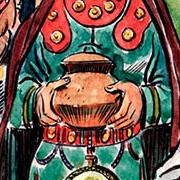 Right now, the game is undergoing internal testing while being finished. Most of the bugs are easy to deal with: fix a typo, clarify something that’s unclear, fix a logic error, or make sure advice and recommendation match.
Right now, the game is undergoing internal testing while being finished. Most of the bugs are easy to deal with: fix a typo, clarify something that’s unclear, fix a logic error, or make sure advice and recommendation match.



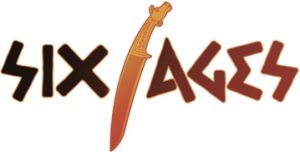
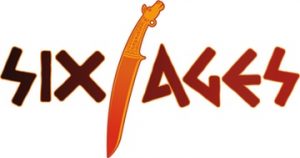
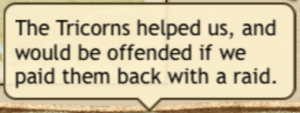 Advice about raiding-related promises currently shows up in the War screen, but if you go to the Raid screen, it doesn’t. As a player I’d be more likely to expect to see it in the Raid screen and would entirely miss it in the War screen.
Advice about raiding-related promises currently shows up in the War screen, but if you go to the Raid screen, it doesn’t. As a player I’d be more likely to expect to see it in the Raid screen and would entirely miss it in the War screen.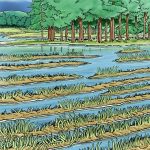 The basic idea behind these tags is that we want to avoid death spirals. If you lose a lot of cattle due to disease, the game won’t feel as fun if you then have a large herd mysteriously disappear. You’ll end up in a hole you won’t be able to dig out of. The occasional flood is fine, but if it happens when you are short of food, it’s just kicking you when you’re down.
The basic idea behind these tags is that we want to avoid death spirals. If you lose a lot of cattle due to disease, the game won’t feel as fun if you then have a large herd mysteriously disappear. You’ll end up in a hole you won’t be able to dig out of. The occasional flood is fine, but if it happens when you are short of food, it’s just kicking you when you’re down.